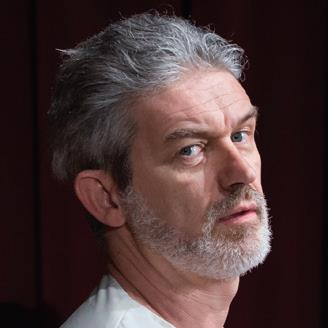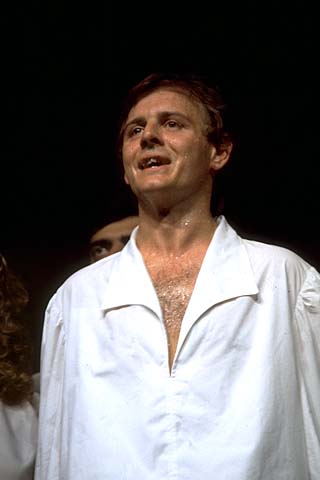CALIGULA AND THE MOON
Musical drama in black and white. Taken from Caligolaby Albert Camus
With Stefano Pesce, Barbara Mautino, Danilo Nigrelli, Giovanni Battaglia, Alberto Mancioppi, Andrea Soffiantini, Andrea Gherpelli, Giampiero Bartolini, Davide Menghi, NicoNote. Project and Direction by Otello Cenci. Director Assistant: Giuditta Mingucci. Music: Marco Mantovani. Visual Designer: Sergio Metalli. Computer Graphics: Mattia Metalli. Light Designer: Vinicio Cheli. Light Designer Assistant: Jacopo Pantani. Sets and Costumes: Manuela Gasperoni,. Assistant Costume Designer: Viola Cheli. Coreography: Maurizio Dolcini.
Caligula speaks of ‘moon’ or ‘happiness’ or ‘immortality’. The insatiable cannot but derive from an inextinguishable. Insatiability is the sign of destiny. Here emerges the great word, from which no one, despite the strongest efforts, no matter how forcefully, whatever tactic, no matter how skilfully, not even in his sleep, can detach himself. A Destiny of immortality is identified in the human experience of insatiability.
Don Luigi Giussani
Realtà e giovinezza. La sfida
Reality and youth. The challenge
To speak about the desire for great things cited in the title of the XXXI edition of the Meeting for Friendship Among the People the figure of Caligula has been chosen, based on one of the most famous texts by Albert Camus, French writer, philosopher e and playwright, who died 50 years ago. He won the Nobel prize for literature in 1957. The leading character of the work is the roman emperor Caligula and his lucid madness, which will lead to his assassination in a conspiracy led by the roman patricians. In the third and final edition of the text, published in 1958, Camus decided to shift one of the central scenes of the play to the beginning: the moment in which Caligula returns to the place after a disappearance of a few days, following the death of his sister, Drusilla.
The dialog which occurs between the emperor and his servant, Elicone, in which Caligula expresses all his desire for the impossibile – I need the moon – becomes the heart of the emperor’s lucid madness, leaving in the background, throughout the evolution of the story, the death of the sister Drusilla. In fact, the protagonist declares: I think I remember that a woman I loved died a few days ago, but what is love? Little enough. This death is nothing, I swear to you, it is but the sign of a truth that makes me need the moon.
The search for the impossible, for something which is not of this world, symbolically represented by the moon, is the new theme for the text and the original driving force for the events which unfold on stage.
Albert Camus wrote in his notes: I need to write things which in part I cannot quite grasp, but which, in effect, represents a proof that what is in me is stronger than myself (Carnet, 1935/1960). That which is within man, but which does not belong to him and supersedes him, something which renders neither possible a complete satisfaction, neither a complete defeat, that does not limit him to be the sum of all his qualities and defects, that render him always out of proportion with the reality in which he lives: Caligula tries to follow this clue, this path towards something higher within man but which seems to lead away from him. This heroic search assumes grotesque proportions, presenting a man of power, determined not to compromise his life with small and partial satisfactions, performing acts which are sometimes senseless, frequently violent, with an apparently cold detachment. Carefully planned famine, humiliating trials forced on subordinates, unjustified murder, these are some of the instruments adopted to ‘make present the impossible’. A battle with the mystery of life, a series of actions blatantly inhumane to trigger the reaction of Someone or Something that man, by his nature waits upon without even knowing.
To emphasise the universal value of the message contained in the text and avoid reducing the play, as frequently happens, to a political-historic denunciation or a criticism of the vices which corrupt the different social classes, the show will be set in an undefined future time. That future which has always been the natural place of dreams and desires. A space without time or precise geographical coordinates.
Essential and geometric lines, spaces invented by the design of lights, which change rapidly, as the look and mood of the protagonist: increasingly imprisoned by his own tragic and rigorous plan. Sets and costumes with any sharp angular contrasts, colours in vicious black












